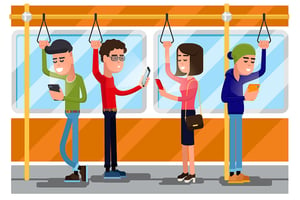Some time ago when meeting with media agencies, I stopped going through a PowerPoint deck to...
Why native advertising is having an identity crisis

I’ve just read an extremely thought provoking article on what I believe to be the biggest challenge to both the native advertising industry (publishers and networks) and media agencies looking to sell native in to clients.
I didn’t just read Chad Pollitt’s piece ‘Native Advertising has a Terminology Problem. And It’s Not Pretty.’ once through – I read it three times. Not because Chad didn’t make sense, but because we’ve got to the stage where even for someone in the thick of this industry, I was still briefly confused.
If someone who works day in, day out in native advertising is having to re-read definitions, then what hope do media buyers (working across multiple platforms, media and formats) have? If one person’s native is Outbrain, and another’s long-form content on a premium publisher, then we have a problem. And that’s before we even look at the myriad of hybrids in the UK market.
Back to basics
Perhaps, it’s best to start with what most people agree is the definition of native advertising:
“Native advertising is paid advertising (media) where the ad matches the form, feel and function of the content of the media on which it appears.” (Native Advertising Institute)
This snappy description seems bulletproof, but it only tells half the story. It accurately describes the sponsored headline unit, the social media sponsored post – the shop window if you like. It’s what happens next which really defines the native format. What happens once the user has read the headline and clicked?
It’s all about the content
This brings us to the content. There’s long been confusion in the market between content marketing and native advertising.
This is one of the easier definitions to solve: Content marketing = your brand content. Native = the distribution channel. I could get into content marketing vs advertorial here (not overtly mentioning your product vs it being all about your product) but that will have to wait for another day.
Social media is somewhat ‘ronseal’ – a sponsored tweet looks like any other tweet, the same for Instagram, Snapchat or Facebook. These usually contain heightened CTAs such as the ‘Learn more’ or ‘Shop now’ banner on Instagram, before clicking to brand sites. Often, the post is simply re-targeting.
There is content, right?
So, what about the traditional publisher’s site? This is where it gets confusing for media buyers. I’d argue it’s all about what happens post-click. This is where the definition of native advertising seems to be far too broad. Any of the following could happen – the headline unit:
- leads to content on the same publisher’s site
- leads to content hosted on the brand site
- opens up a lightbox containing brand content
- plays video
- doesn’t actually lead to any content at all. It’s a headline unit that simply clicks to a product page!
Essentially, your headline unit could behave in several different ways and in some instances, is no more than a re-badged direct response banner ad.
Here’s my attempt to clarify the main (non-video) formats on publisher’s sites:
Native advertising (sponsored content)
Non-programmatic, publisher direct sold headline units that lead to article pages in the same premium environment.
True Native (sponsored content)
Non-programmatic, ad served headline units that lead to article pages in the same premium environment.
Native display
An in-feed headline unit on a publisher site that clicks to a brand site which may or may not contain content marketing. Usually programmatic demand from exchanges and often re-targeting.
Content recommendation
The likes of Outbrain, Taboola and Rev. Self-serve headline units which click out, usually in blocks of 6 or 12 at the bottom of article pages. Usually DR campaigns or arbitrage.
Should ‘native advertising’ be redefined?
Chad argues that the confusion in the market is all about the definitions of types of content, I’d argue that there’s far more confusion over what a headline unit does.
Perhaps now is the time to separate premium sponsored content (in editorial environments) from what recent IAB UK native conference called ‘next generation display advertising’. Perhaps, the term ‘native advertising’ has had its day!


